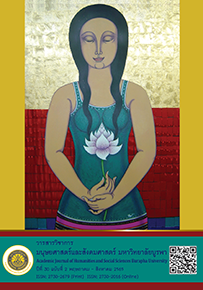Corporate Branding via Brand Experiences Creation: The Faculty of Music and Performing Arts, Burapha University Case Study
Main Article Content
Abstract
This article aimed at providing insights about corporate branding via brand experience creation with the stakeholders in order to gain brand image in a positive way. The author proposed the brand experience concept and the case study of the Faculty of Music and Performing Arts (MUPA) Brand, Burapha University via Thai Country Song Singing Contest at the Higher Education Level of Thailand for the Royal Cup of HRH Princess Maha Chakri Sirindhorn event. This event was integrated the classes’ instructions and knowledge sharing among MUPA’s lecturers, officers, current students and ex-students, including corporate brand communicating with the outside audiences. The event evaluation reflected changing stakeholders’ attitudes toward MUPA in positive ways after participating the activities.
Downloads
Article Details

This work is licensed under a Creative Commons Attribution-NonCommercial-NoDerivatives 4.0 International License.
บทความทุกบทความเป็นลิขสิทธิ์ของวารสารวิชาการมนุษยศาสตร์และสังคมศาสตร์ มหาวิทยาลัยบูรพาเท่านั้น
References
กุณฑลี รื่นรมย์. (2563). Corporate brand success valuation (พิมพ์ครั้งที่ 4). ไซเบอร์พริ้นท์กรุ๊ป.
นริสรา พึ่งโพธิ์สภ, ฐาศุกร์ จันประเสริฐ, ดุษฎี โยเหลา และเชาวนี แก้วมโน. (2559). การรับรู้ภาพลักษณ์แบรนด์ การสร้างแบรนด์ภายใน และความยึดมั่นด้านความรู้สึก ต่อแบรนด์องค์กรของบุคลากรในมหาวิทยาลัย. วารสารพฤติกรรมศาสตร์เพื่อการพัฒนา, 8(2), 71-91.
ปฐมาพร เนตินันทน์. (2554). การสังเคราะห์กระบวนการและกลยุทธ์การสร้างตราสินค้า. วารสารนักบริหาร มหาวิทยาลัยกรุงเทพ, 31(2), 36-50.
ปรีดี นุกุลสมปรารถนา. (2563ก, 9 มีนาคม). ความแตกต่างระหว่าง corporate brand และ product brand.
https://www.popticles.com/branding/corporate-brand-vs-product-brand/
ปรีดี นุกุลสมปรารถนา. (2563ข, 12 กรกฎาคม). วิธีสร้าง brand experience ให้ประทับใจ. https://www.popticles.com/branding/create-impressive-brand-experience/
เอสเอ็มอี ไทยแลนด์. (2562, 27 พฤษภาคม). หมัดฮุก ‘experience’ กลยุทธ์หยุดลูกค้าตั้งแต่แรกพบด้วยประสบการณ์. https://www.smethailandclub.com/marketing-4557-id.html
Aberg L. E. G. (1990). Theoretical model and praxis of total communications. International Relations Review, 13(2), 13-16.
Bunzel, D. L. (2007). Universities sell their brands. Journal of Product & Brand Management, 16(2), 152-153.
Pincus, J. D., Robert, A. P. R., Rayfield, A. P. R., & DeBonis, J. N. (1991). Transforming CEOs into chief communications officer. Public Relations Journal, 47(11), 22-27.
Pine, J. B. II, & Gilmore, J. (1999). The experience economy. Harvard Business School Press.
Schmitt, B. H. (1999). Experiential marketing. Free Press.
Sharma, N., & Kamalanabhan, T. (2012). Internal corporate communication and its impact on internal branding: Perception of Indian public sector employees. Corporate Communications: An International Journal, 17(3), 300-322.
Van Riel, C. B. M. (1995). Principles of corporate communication. Prentice Hall.
Williams, M. (2000). Is a company’s intellectual capital performance and intellectual capital disclosure practices related? Evidence from publicly listed companies from the FTSE 100. Paper Presented at McMasters Intellectual Capital Conference. January 2001, Hamilton Ontario.
WP. (2559, 29 สิงหาคม). เมื่อ “corporate brand” คือ ความยั่งยืน ถึงเวลาองค์กรต้องให้ความสำคัญ. https://www.brandbuffet.in.th/2016/08/corporate-brand-sustainability/


